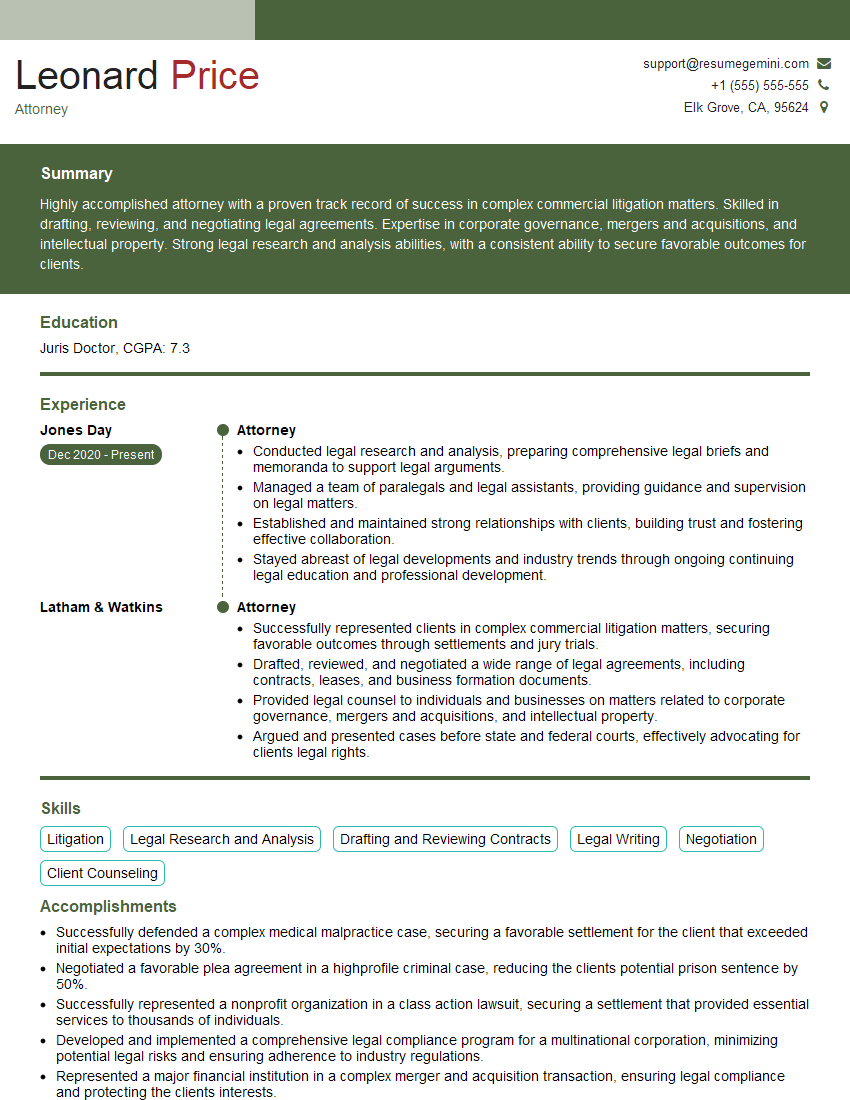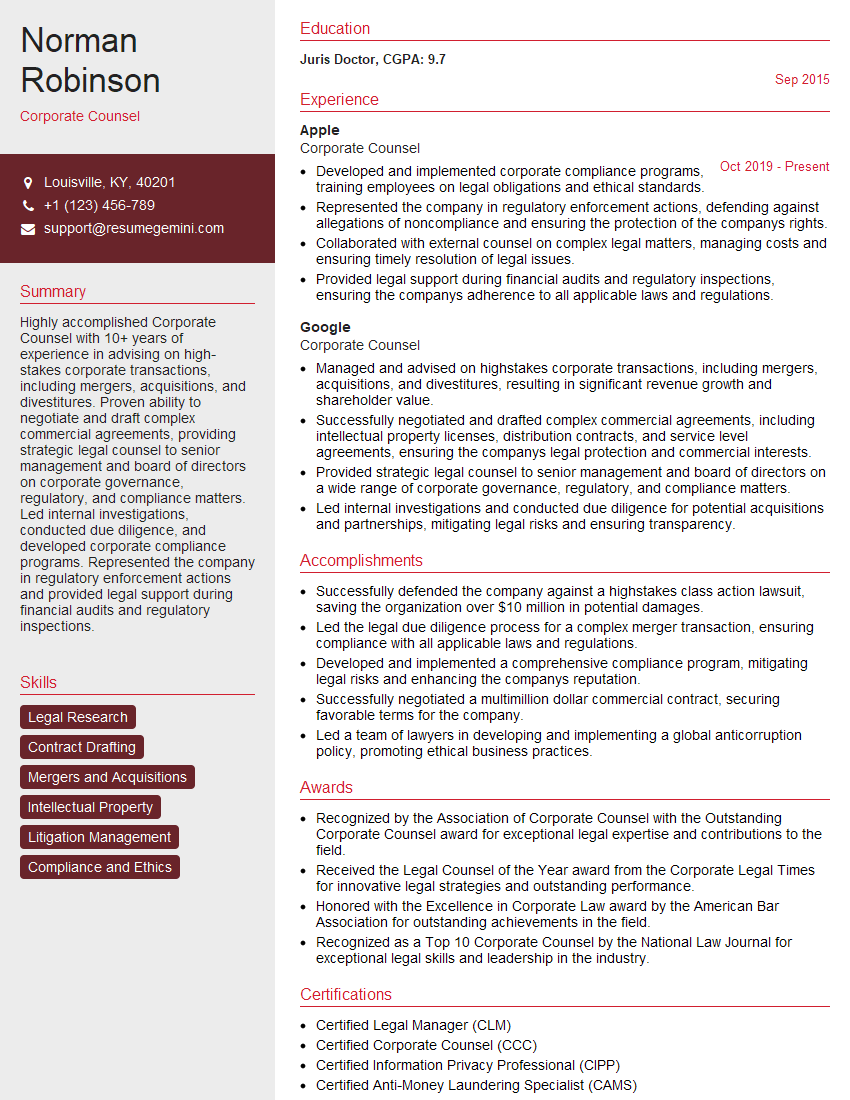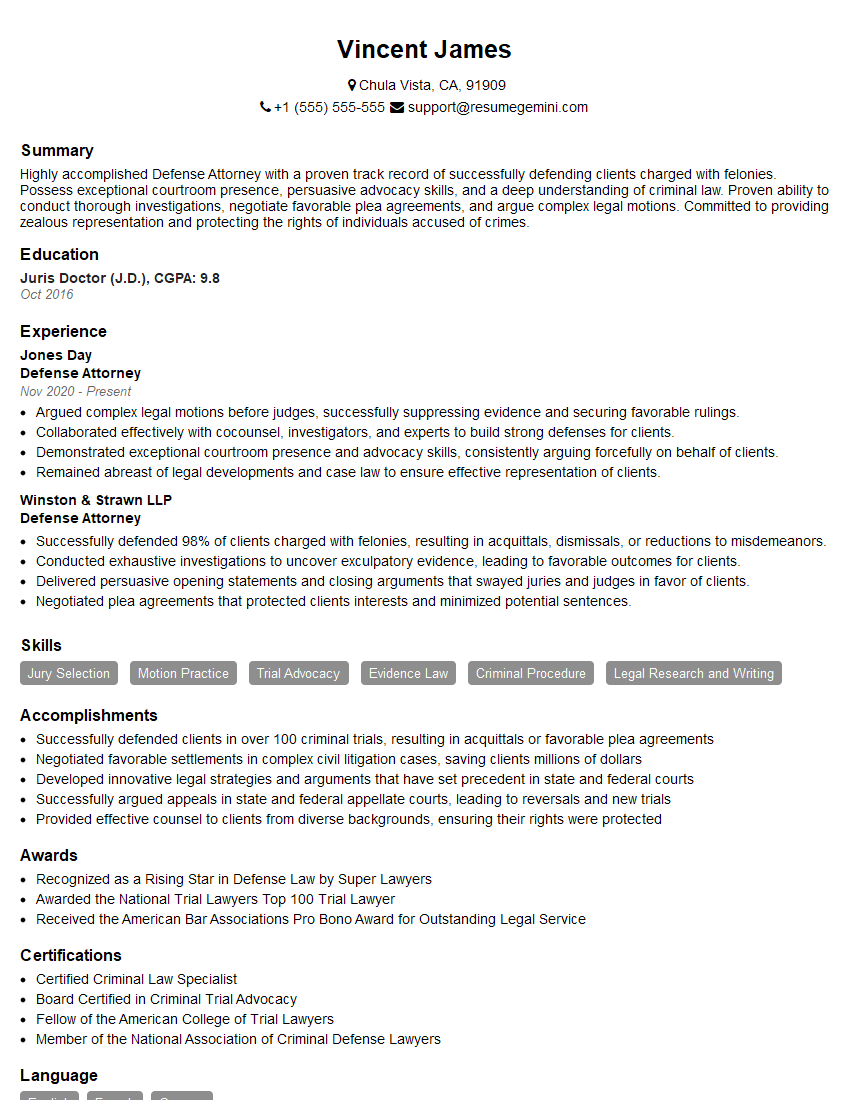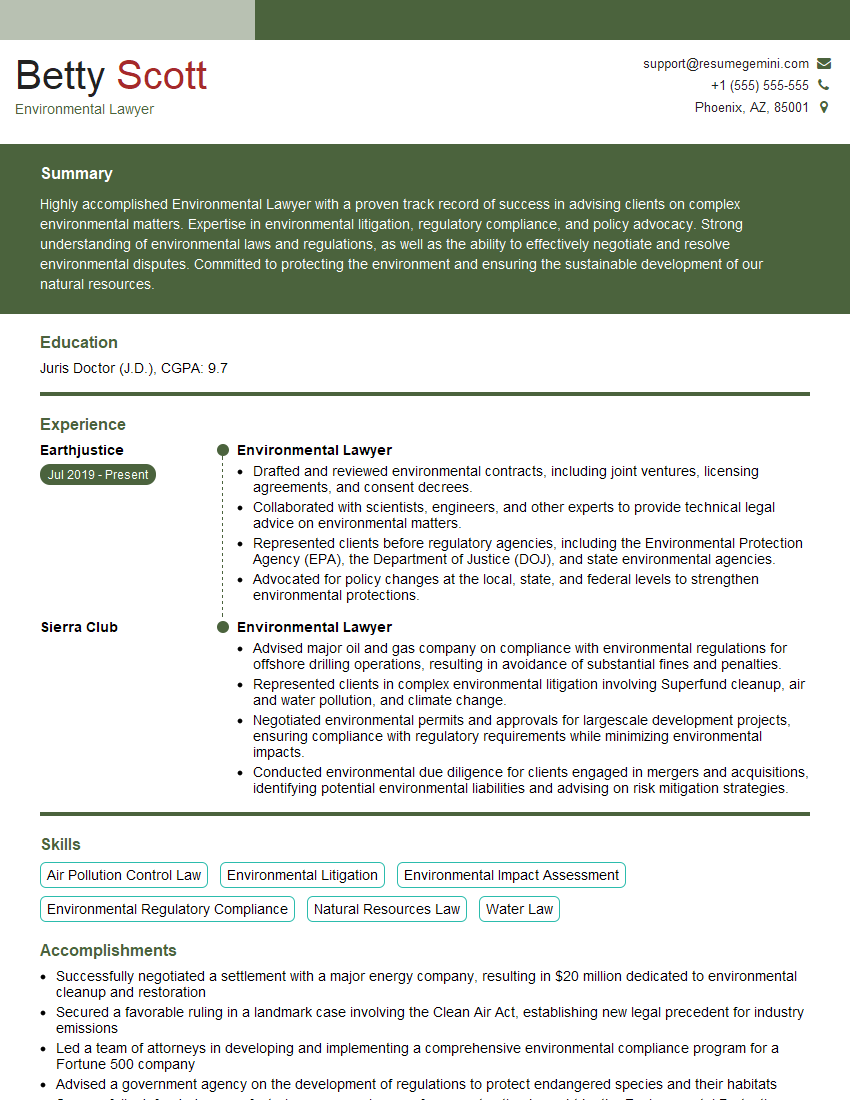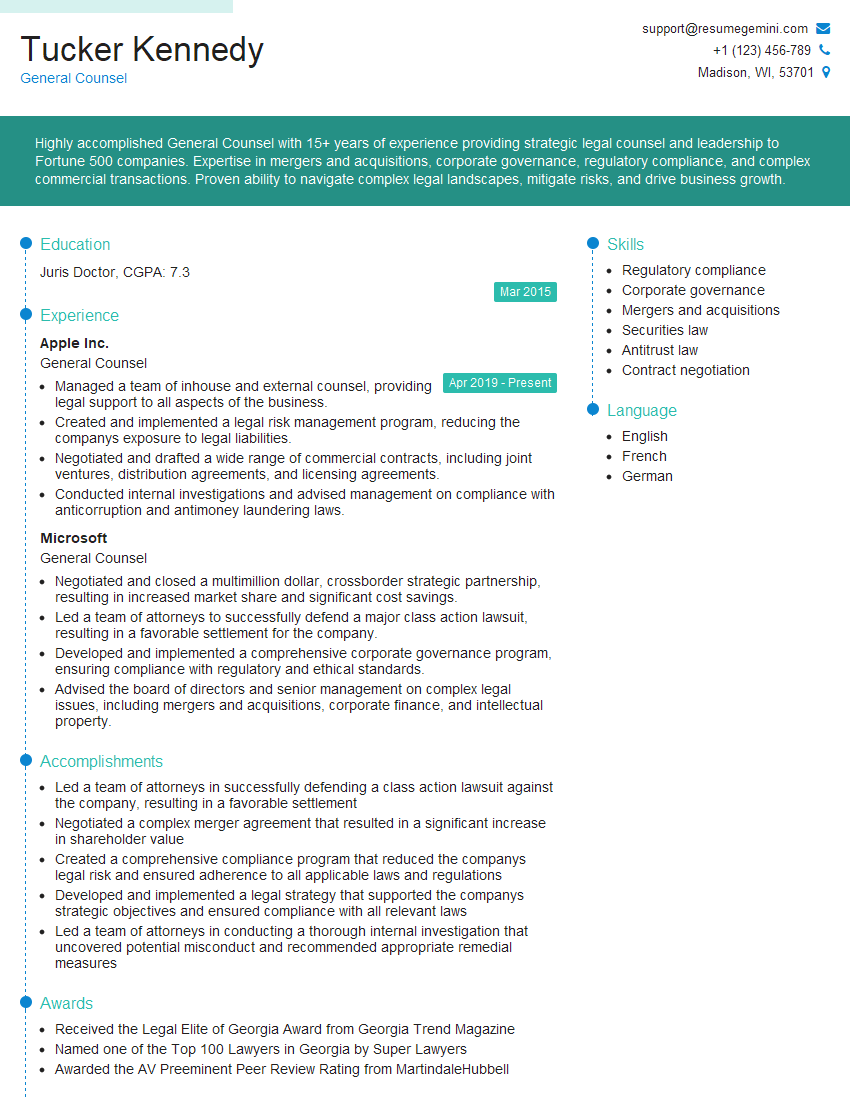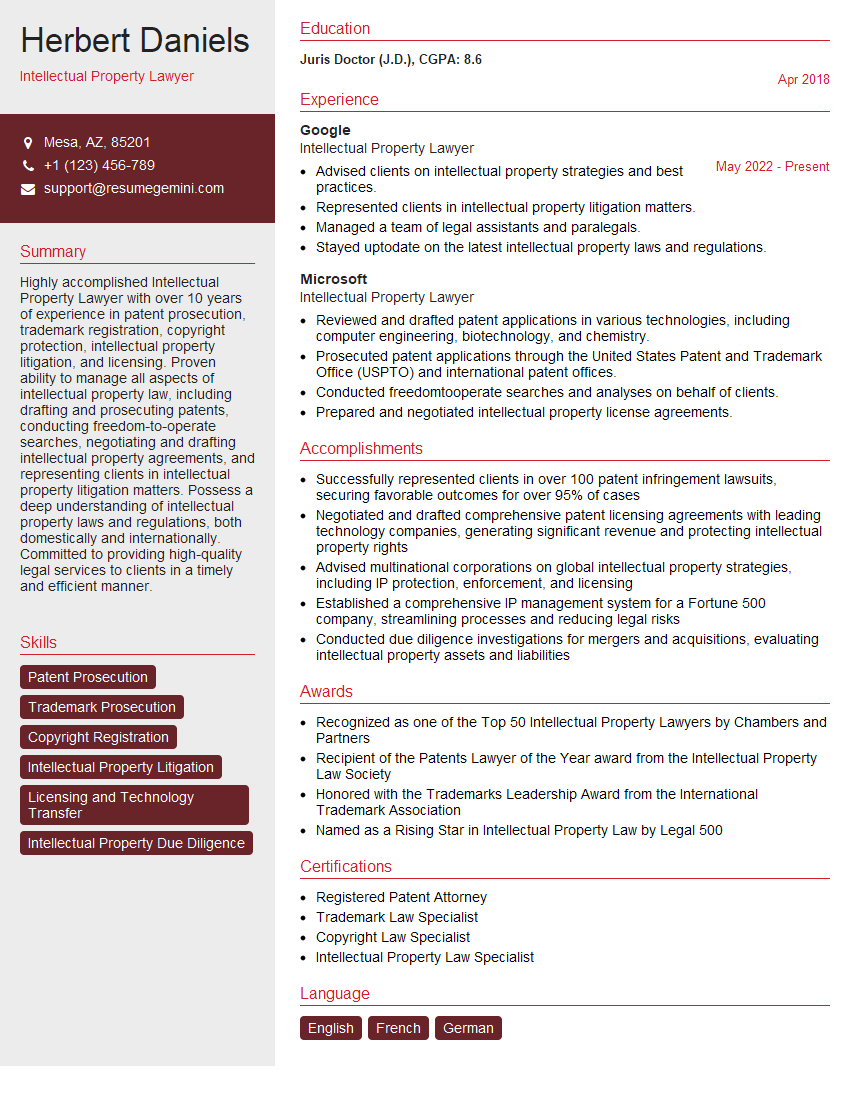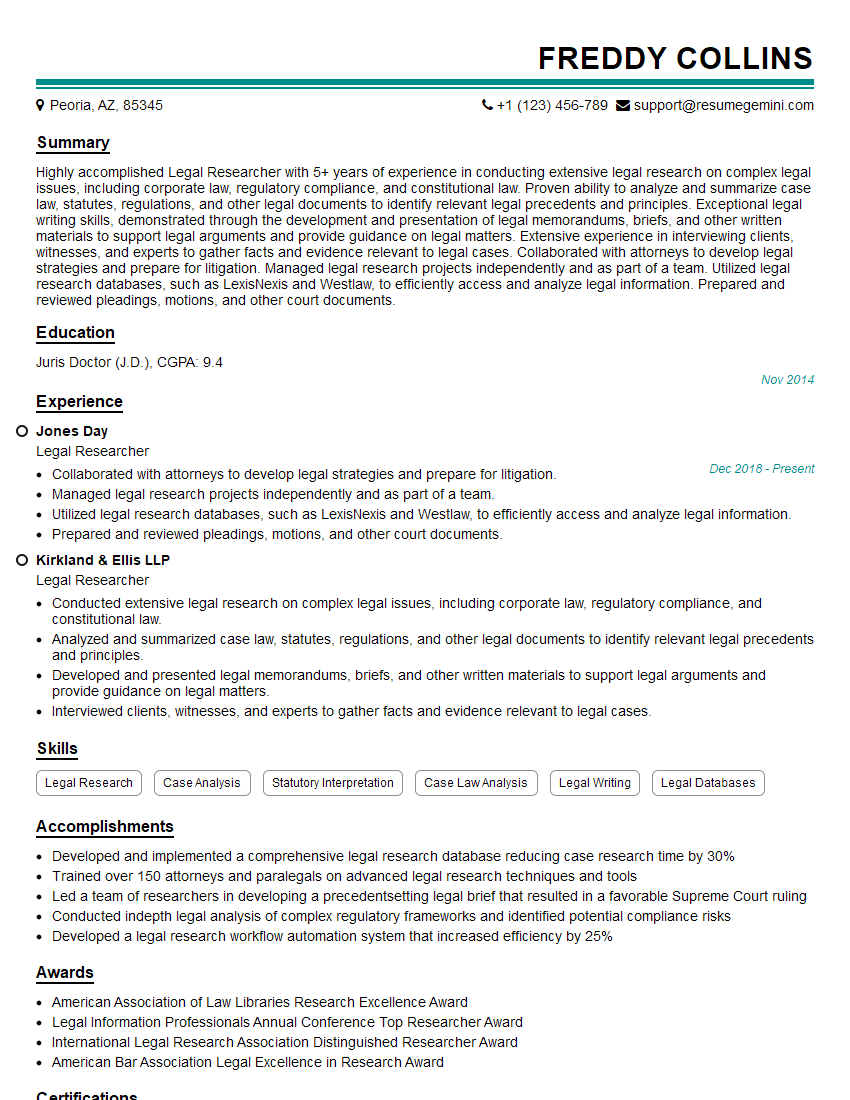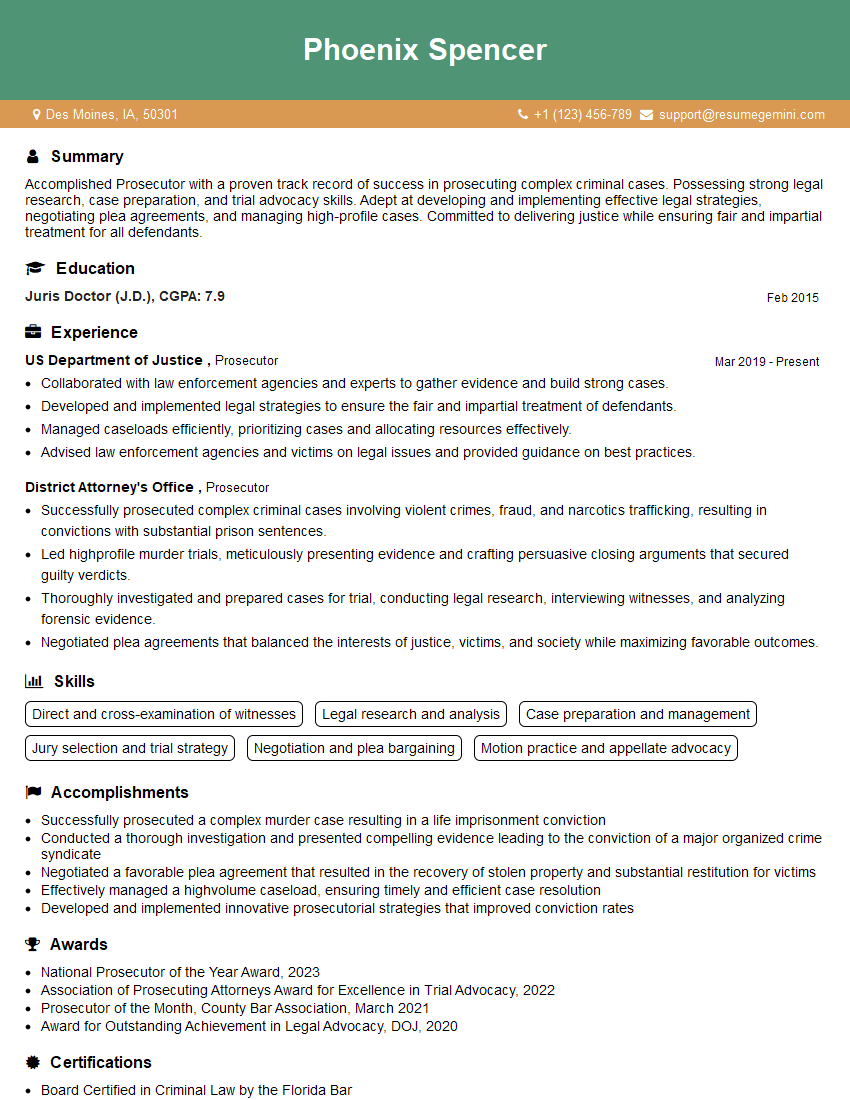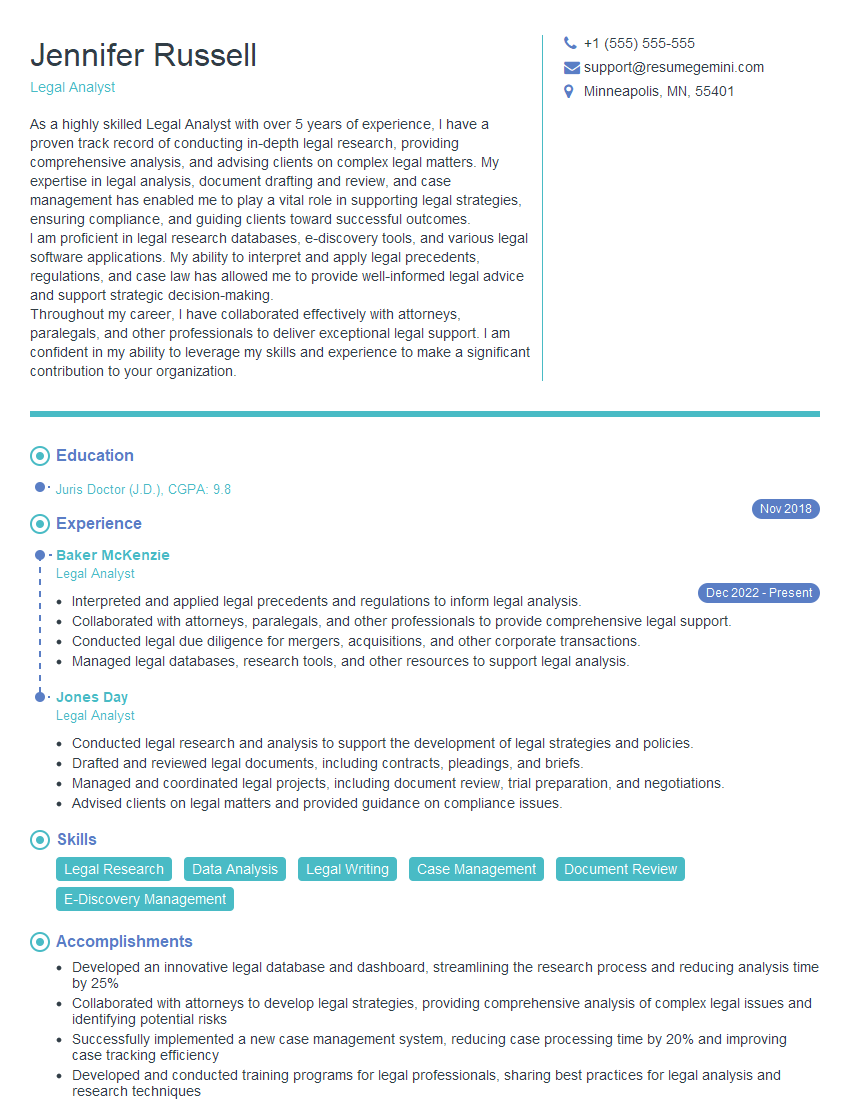Preparation is the key to success in any interview. In this post, we’ll explore crucial Understanding and Applying Legal Principles interview questions and equip you with strategies to craft impactful answers. Whether you’re a beginner or a pro, these tips will elevate your preparation.
Questions Asked in Understanding and Applying Legal Principles Interview
Q 1. Explain the difference between civil and criminal law.
Civil and criminal law are two distinct branches of law with different goals and procedures. Criminal law deals with actions that are considered harmful to society as a whole. The government prosecutes individuals accused of crimes, aiming to punish them and deter future wrongdoing. Examples include theft, assault, and murder. The burden of proof is high, requiring “beyond a reasonable doubt.” Penalties can range from fines to imprisonment.
In contrast, civil law concerns disputes between individuals or organizations. These cases typically involve issues like breach of contract, negligence, or property disputes. An individual or company brings a lawsuit, seeking compensation (damages) or other remedies. The burden of proof is lower, usually “preponderance of the evidence.” Outcomes may involve financial compensation or injunctions (court orders to do or not do something).
Imagine a car accident: if someone is charged with reckless driving leading to the accident, that’s a criminal case. If the injured party sues the driver for medical bills and property damage, that’s a civil case. The same event can give rise to both criminal and civil proceedings.
Q 2. Describe the elements of a legally binding contract.
A legally binding contract requires several key elements: offer, acceptance, consideration, intention to create legal relations, and capacity. An offer is a clear proposal by one party to another, indicating willingness to enter an agreement. Acceptance signifies the other party’s unconditional agreement to the terms of the offer. Consideration involves the exchange of something valuable between the parties – it could be money, goods, services, or a promise to do or refrain from doing something. The parties must have intention to create legal relations – meaning they intend the agreement to be legally enforceable. Finally, both parties must have the capacity to contract (legal age and sound mind).
For example, if you agree to buy a car from a dealership for a certain price, that’s an offer and acceptance. The price is the consideration. Both parties intend the agreement to be binding, and assuming you’re of legal age and the dealer is a legitimate business, capacity is met.
Q 3. What are the key components of a negligence claim?
To establish negligence, a claimant (the person bringing the lawsuit) must prove four elements: duty of care, breach of duty, causation, and damages. A duty of care exists when one person has a legal responsibility to avoid causing harm to another. A breach of duty occurs when the person fails to meet that responsibility. Causation requires demonstrating that the breach of duty directly caused the claimant’s harm (this often involves demonstrating both factual causation and proximate causation). Finally, damages refer to the actual harm suffered by the claimant, such as physical injury, property damage, or emotional distress.
Consider a case where a store owner fails to clean up a spill (breach of duty), causing a customer to slip and injure themselves (causation and damages). The store owner owed the customer a duty of care to maintain a safe environment. The failure to clean up the spill directly caused the customer’s injuries.
Q 4. How would you analyze a complex legal case involving multiple statutes?
Analyzing a case with multiple statutes involves a systematic approach. First, you carefully identify all relevant statutes. Then, you need to understand each statute’s specific requirements, definitions, and exceptions. Next, you’ll analyze how these statutes interact with each other – are there conflicts, overlaps, or do they complement one another? You must determine the hierarchy of the statutes if there’s a conflict, considering which statute is more recent or which statute takes precedence. This may require examining legislative history and considering the intent of the legislature. Finally, apply the relevant statutes to the facts of the case, considering the legal tests and burdens of proof established in each statute.
A common example is a case involving both federal and state laws. A court must determine which law applies in case of a conflict, usually prioritizing the more specific or more recent legislation.
Q 5. Explain the concept of precedent and its importance in legal decision-making.
Precedent, also known as stare decisis (Latin for “to stand by things decided”), is the principle that courts should follow previous decisions when deciding similar cases. It promotes consistency and predictability in the law. Higher courts’ decisions bind lower courts within the same jurisdiction. Precedent doesn’t mean courts are inflexible; judges can distinguish cases from precedent if the facts or relevant law are sufficiently different, or even overturn existing precedent in exceptional circumstances.
Imagine a case involving dog bites. If a higher court ruled that a dog owner is liable for a bite, lower courts in that jurisdiction will likely follow that decision in future dog bite cases unless a new argument or factual difference is presented.
Q 6. What are the different types of legal research methods?
Legal research methods vary depending on the complexity of the issue and the available resources. Key methods include: primary sources (statutes, case law, constitutions); secondary sources (law review articles, treatises, legal encyclopedias); and tertiary sources (legal dictionaries, indexes). Effective legal research often involves a combination of methods, starting with a broad search using tertiary sources to refine the focus, then moving to more specific primary and secondary resources. Additionally, electronic databases (like Westlaw or LexisNexis) are essential tools for accessing legal materials efficiently.
Q 7. How would you approach researching a legal issue you are unfamiliar with?
Approaching an unfamiliar legal issue requires a structured approach. Begin by clearly defining the specific legal question. Then, use tertiary sources (legal encyclopedias, dictionaries) to get an overview of the area of law. This provides a framework and identifies key terms and concepts. Next, consult secondary sources (law review articles, treatises) to gain deeper understanding and identify relevant case law and statutes. Finally, analyze the primary sources (case law and statutes) to find the most relevant and authoritative information. Keep detailed notes and organize your research meticulously. If necessary, seek guidance from experienced professionals or legal research librarians.
Imagine researching the legal implications of AI in employment law. You’d start with basic definitions, then explore scholarly articles on the topic, and finally, analyze relevant statutes and case law dealing with discrimination and employment contracts. This systematic approach ensures you comprehensively address the legal issue.
Q 8. Describe your understanding of intellectual property law.
Intellectual property (IP) law protects creations of the mind, such as inventions, literary and artistic works, designs, and symbols, names, and images used in commerce. It’s designed to incentivize innovation and creativity by granting creators exclusive rights over their work for a specific period. This protection comes in several forms.
- Patents: Protect inventions, granting the inventor exclusive rights to use, sell, and manufacture their invention for a set period.
- Copyrights: Protect original works of authorship, including literary, dramatic, musical, and certain other intellectual works. This protection extends to the expression of an idea, not the idea itself.
- Trademarks: Protect brand names, logos, and other identifying marks used to distinguish goods and services in the marketplace. They prevent others from using confusingly similar marks.
- Trade Secrets: Protect confidential information that provides a business with a competitive edge, such as formulas, practices, designs, instruments, or a compilation of information.
For example, a pharmaceutical company might patent a new drug, a novelist might copyright their book, and a clothing company might trademark its logo. Understanding IP law is crucial for businesses to protect their assets and for individuals to safeguard their creative work. Infringement of IP rights can lead to significant legal consequences, including injunctions, monetary damages, and even criminal prosecution.
Q 9. Explain the concept of due process.
Due process is a fundamental principle of law that ensures fairness and justice in legal proceedings. It guarantees that individuals are treated fairly and have the opportunity to be heard before the government takes action that affects their rights or liberties. This principle is enshrined in the Fifth and Fourteenth Amendments of the US Constitution.
Due process has two main components:
- Procedural Due Process: This focuses on the fairness of the procedures used to deprive someone of life, liberty, or property. It requires the government to follow established procedures, provide notice of the proceedings, and allow the individual an opportunity to be heard and present their case.
- Substantive Due Process: This focuses on whether the government’s actions themselves are fair and reasonable. It protects against arbitrary or unreasonable government actions, even if the procedures followed were technically proper. It essentially asks whether the law itself is fair.
An example of procedural due process would be the right to an attorney, the right to confront witnesses, and the right to a trial. An example of substantive due process would be a challenge to a law that arbitrarily discriminates against a particular group.
The concept of due process is vital for ensuring that government power is not abused and that individuals’ rights are protected. It’s a cornerstone of a just and equitable legal system.
Q 10. What are the ethical considerations for a legal professional?
Ethical considerations for legal professionals are paramount. They are guided by rules of professional conduct, often codified in professional codes of ethics (such as the ABA Model Rules of Professional Conduct). These rules are designed to maintain public trust and confidence in the legal profession. Key ethical considerations include:
- Confidentiality: Maintaining client confidentiality is crucial, protecting privileged communications. This is essential for building trust and ensuring clients feel comfortable sharing sensitive information.
- Competence: Legal professionals must maintain a high level of competence and diligence in their work, staying up-to-date on relevant laws and procedures.
- Integrity: Honesty and truthfulness are paramount. This includes accurately representing facts to the court and acting with integrity in all dealings.
- Impartiality: Legal professionals should strive to be impartial and objective in their representation, even when dealing with difficult clients or cases.
- Conflicts of Interest: Avoiding conflicts of interest is critical. This includes carefully reviewing potential conflicts before accepting representation to ensure they can provide unbiased advice and representation.
Ethical dilemmas frequently arise, and legal professionals must carefully weigh their obligations to their clients, the court, and the public interest. Failure to adhere to these ethical principles can result in disciplinary action, including suspension or disbarment.
Q 11. How would you handle a conflict between client confidentiality and legal obligations?
The conflict between client confidentiality and legal obligations is a challenging ethical dilemma for legal professionals. The attorney-client privilege protects confidential communications between a lawyer and their client, but there are exceptions. This requires a careful and nuanced approach.
Steps to handle such a conflict:
- Identify the conflict: Clearly define the nature of the confidential information and the legal obligation that seemingly conflicts with it.
- Seek guidance: Consult with colleagues, ethics experts, or professional bar associations to explore options and ensure compliance with relevant ethical rules.
- Explore all possible solutions: Attempt to find ways to fulfill legal obligations without disclosing privileged information. This might involve limited disclosure, seeking alternative means of complying with legal requirements, or advising the client of the need to disclose information themselves.
- Document everything: Meticulously document all steps taken, consultations sought, and decisions made. This record is essential for justification if the matter comes under scrutiny.
- Act in good faith: All actions must be taken in good faith, aiming to protect the client’s rights while complying with all applicable laws and ethical rules.
- Consider withdrawal if necessary: If no ethical solution can be found, the lawyer may have to withdraw from representation to avoid breaching confidentiality or violating their legal obligations.
The specific steps depend on the jurisdiction and the nature of the conflict. Each case must be carefully analyzed based on the specific facts and relevant legal authority. The priority is to act ethically and in compliance with professional standards.
Q 12. Explain the differences between mediation and arbitration.
Mediation and arbitration are both alternative dispute resolution (ADR) methods that offer alternatives to traditional litigation. However, they differ significantly in their processes and outcomes.
- Mediation: A neutral third party, the mediator, facilitates communication and negotiation between the disputing parties. The mediator does not decide the outcome but helps the parties reach a mutually acceptable agreement. The process is generally less formal and more flexible than arbitration.
- Arbitration: A neutral third party, the arbitrator, hears evidence and arguments from both sides and renders a binding decision. The arbitrator acts as a private judge, and their decision is usually final and enforceable in court. The process is more formal, resembling a court proceeding.
Key Differences Summarized:
| Feature | Mediation | Arbitration |
|---|---|---|
| Decision-Maker | Parties themselves | Arbitrator |
| Outcome | Agreement reached by parties | Binding decision by arbitrator |
| Formality | Informal | Formal |
| Enforceability | Contractual | Legally enforceable |
For example, a landlord-tenant dispute might be effectively resolved through mediation, while a complex commercial contract dispute might be better suited for arbitration. The choice between mediation and arbitration depends on the nature of the dispute, the parties’ preferences, and the desired outcome.
Q 13. What is the statute of limitations, and how does it affect legal cases?
The statute of limitations is a law that sets the maximum time after an event within which legal proceedings may be initiated. This time limit varies depending on the type of legal claim and the jurisdiction. The purpose is to prevent stale claims where evidence is lost, memories fade, and witnesses become unavailable.
How it affects legal cases:
- Bars claims: If a lawsuit is not filed within the statute of limitations period, the court will typically dismiss the case, preventing the plaintiff from pursuing their claim.
- Affects evidence gathering: The statute of limitations affects the ability to gather evidence. As time passes, crucial evidence may be lost or destroyed, making it harder to prove the case.
- Impacts witness testimony: Witnesses’ memories can fade, making their testimony less reliable as time passes.
- Creates legal certainty: The statute of limitations provides legal certainty by establishing a clear timeframe for resolving disputes.
For example, the statute of limitations for personal injury claims is typically much shorter than that for contract disputes. A failure to file a claim within the prescribed time frame can result in a permanent loss of legal recourse.
Understanding the relevant statute of limitations is critical for both plaintiffs and defendants. Missing the deadline can have devastating consequences.
Q 14. Describe your experience with legal drafting and writing.
I have extensive experience in legal drafting and writing, encompassing various legal documents including contracts, pleadings, motions, briefs, and legal opinions. My experience includes:
- Contract Drafting: I’ve drafted and reviewed numerous contracts, ensuring clarity, completeness, and enforceability. This includes understanding the nuances of contract law, such as offer, acceptance, consideration, and conditions.
- Pleading and Motion Drafting: I’ve prepared various pleadings, such as complaints, answers, and motions, adhering to strict procedural rules and ensuring compliance with court requirements. This includes meticulously researching legal precedents and crafting persuasive arguments.
- Brief Writing: I’ve drafted appellate briefs, articulating complex legal issues concisely and persuasively for appellate courts. This requires a strong understanding of appellate procedure and the ability to synthesize large amounts of information into a coherent narrative.
- Legal Opinion Writing: I’ve prepared legal opinions providing advice and analysis on various legal matters, supported by relevant legal authority. This demands precise language and careful attention to detail.
I am proficient in using legal research databases and tools to ensure the accuracy and completeness of my work. I consistently strive for clarity, precision, and persuasiveness in my writing, recognizing that effective legal writing is crucial for achieving favorable outcomes for clients. My experience spans various practice areas, allowing me to adapt my style and approach to the specific needs of each document and legal context.
Q 15. How would you analyze a contract for potential risks or liabilities?
Analyzing a contract for potential risks and liabilities involves a systematic review focusing on several key areas. It’s like a thorough car inspection before buying – you want to identify any potential problems before you’re committed.
Identification of Parties and Obligations: Clearly define who the parties are and their respective responsibilities. Ambiguity here can lead to disputes. For example, unclear payment terms could result in late payment penalties or breach of contract claims.
Warranties and Representations: Scrutinize any statements of fact made by one party to the other. Are these accurate? If false, they could lead to claims for breach of warranty. Consider, for example, a warranty on the quality of goods sold – if the goods are defective, the buyer might have legal recourse.
Limitation of Liability Clauses: Carefully review clauses that limit the liability of one or both parties. Are these limitations reasonable and enforceable? Extremely restrictive clauses might be deemed unconscionable and unenforceable. For instance, a clause completely excluding liability for negligence might not hold up in court.
Termination Clauses: Understand the circumstances under which either party can terminate the contract. What are the consequences of termination? A poorly drafted termination clause could leave a party vulnerable to significant losses.
Governing Law and Dispute Resolution: Determine the applicable law and the method for resolving disputes (e.g., arbitration, litigation). This is crucial because different jurisdictions have different legal rules and procedures.
Force Majeure Clauses: Analyze clauses that excuse performance due to unforeseen events (e.g., natural disasters, war). These clauses help manage risk associated with events beyond the parties’ control. Make sure the definition of ‘force majeure’ is clear and covers relevant scenarios.
By methodically examining these aspects, I can identify potential risks and liabilities, allowing for proactive mitigation strategies, such as negotiating favorable contract terms or obtaining appropriate insurance.
Career Expert Tips:
- Ace those interviews! Prepare effectively by reviewing the Top 50 Most Common Interview Questions on ResumeGemini.
- Navigate your job search with confidence! Explore a wide range of Career Tips on ResumeGemini. Learn about common challenges and recommendations to overcome them.
- Craft the perfect resume! Master the Art of Resume Writing with ResumeGemini’s guide. Showcase your unique qualifications and achievements effectively.
- Don’t miss out on holiday savings! Build your dream resume with ResumeGemini’s ATS optimized templates.
Q 16. Explain the concept of burden of proof.
The burden of proof is the obligation on a party in a legal case to prove the facts necessary to win its case. It’s like being the prosecuting attorney in a courtroom drama – you have to convince the judge or jury that your version of events is the true one. The standard of proof varies depending on the type of case.
Beyond a Reasonable Doubt: Used in criminal cases, this is the highest standard of proof. The prosecution must demonstrate that there is no reasonable doubt in the mind of a reasonable person that the defendant committed the crime. Think of it as needing near-certainty.
Preponderance of the Evidence (or Balance of Probabilities): Used in civil cases, this requires showing that it is more likely than not that the plaintiff’s claims are true. This is a lower standard than beyond a reasonable doubt; think of it as ‘more likely than not’.
Clear and Convincing Evidence: A standard between the two above, used in some civil cases, requiring a higher degree of certainty than preponderance but less than beyond a reasonable doubt. This demands a firm belief that the facts asserted are true.
Understanding the burden of proof is essential in legal analysis, as it determines which party bears the risk of not being able to prove their case. For example, in a negligence case, the plaintiff must prove the defendant owed a duty of care, breached that duty, and caused the plaintiff’s injuries.
Q 17. What are your experiences with legal technology and research tools?
I have extensive experience with various legal technology and research tools. My proficiency includes Westlaw, LexisNexis, and Bloomberg Law, enabling efficient and comprehensive legal research. I am also adept at using case management software, document review platforms, and e-discovery tools. In one recent project, using Westlaw’s advanced search features, I quickly located precedent setting cases concerning contract interpretation and saved the firm countless hours of manual research. I also have experience with tools that analyze large datasets of legal documents, assisting in identifying trends and patterns in litigation.
Beyond commercial platforms, I am familiar with open-source legal research tools and databases, which have proven invaluable for locating specialized or less mainstream legal materials. My skills encompass not just the technical operation of these tools but also the strategic application of search techniques to extract the most relevant and pertinent information for a given legal problem.
Q 18. How would you explain a complex legal concept to a non-legal professional?
Explaining complex legal concepts to non-legal professionals requires simplifying jargon and using analogies. Imagine trying to explain quantum physics to a five-year-old; it needs a different approach than explaining it to a physicist.
For example, to explain the concept of ‘stare decisis‘ (the principle of following precedent), I wouldn’t use legal terms. Instead, I might say, “Imagine a cookbook. Each successful recipe is like a court case that sets a rule. Future chefs (judges) generally follow those recipes unless there’s a good reason to change them.” This analogy makes the principle of relying on prior decisions easy to grasp.
Another example: explaining ‘contract consideration‘. Instead of defining it legally, I’d use an everyday example: “Imagine you trade your old phone for a friend’s bicycle. Each of you gives something up to get something you want – that’s consideration. Without that exchange, it’s not a real contract.” This practical example clarifies the requirement of mutual exchange of value.
I tailor my explanations to the audience’s level of understanding, using plain language, visual aids (where appropriate), and real-world examples to illustrate the concepts clearly and engagingly.
Q 19. What are the different types of legal remedies available?
Legal remedies are the means by which a court enforces a right, imposes a penalty for a wrong, or prevents future harm. They fall into two main categories:
Monetary Remedies: These involve financial compensation. Examples include:
Damages: Financial compensation for losses suffered due to a breach of contract or a tort (civil wrong). These can be compensatory (covering actual losses), punitive (intended to punish the wrongdoer), or nominal (acknowledging a wrong without significant financial loss).
Restitution: The return of property or money unjustly obtained.
Equitable Remedies: These are non-monetary and are granted when monetary remedies are insufficient. Examples include:
Injunction: A court order requiring someone to do or stop doing something.
Specific Performance: A court order requiring a party to fulfill a contractual obligation (typically only in cases involving unique goods or services).
Declaratory Judgment: A court’s statement of the rights and obligations of the parties, clarifying legal issues without awarding damages.
The choice of remedy depends on the specific facts of the case and the nature of the harm suffered. For example, in a breach of contract for the sale of land, specific performance might be appropriate since land is unique. However, in a breach of contract for the sale of a commodity, damages would typically suffice.
Q 20. Describe your understanding of the rules of evidence.
The rules of evidence govern what evidence is admissible in court. They aim to ensure that only reliable and relevant information is considered by the judge or jury. Think of it as quality control for facts presented in a courtroom. They are designed to prevent unreliable or prejudicial information from influencing the outcome of a case. Key concepts include:
Relevance: Evidence must be relevant to the issues in the case. Irrelevant information is excluded.
Authenticity: Evidence must be what it purports to be. For example, a document must be shown to be genuine, not a forgery.
Hearsay: Generally, out-of-court statements offered to prove the truth of the matter asserted are inadmissible. There are exceptions to this rule.
Best Evidence Rule: The original documents or recordings should be presented, not copies, unless a valid reason exists.
Privilege: Certain communications are protected from disclosure, such as attorney-client privilege.
Competency of Witnesses: Witnesses must be able to understand and take an oath, and possess personal knowledge of the facts to which they testify.
Understanding these rules is crucial for effective legal practice, as they dictate what evidence can be presented and how it can be presented to the court. Incorrect application of these rules can lead to the exclusion of crucial evidence, potentially affecting the outcome of the case.
Q 21. How would you manage your time and workload in a fast-paced legal environment?
Managing time and workload effectively in a fast-paced legal environment requires a structured approach. It’s like being an air traffic controller, needing to prioritize and manage multiple tasks simultaneously. My strategies include:
Prioritization: I use tools like prioritization matrices (Eisenhower Matrix) to identify urgent and important tasks, ensuring that time-sensitive matters are addressed promptly.
Time Blocking: I schedule specific blocks of time for particular tasks, minimizing interruptions and enhancing focus. This ensures dedicated time for research, writing, client communication, and court appearances.
Delegation: Where appropriate, I delegate tasks to junior colleagues or paralegals, optimizing my time for high-level tasks requiring my expertise.
Technology: I utilize legal technology tools and software to automate repetitive tasks, like document review, freeing up time for more strategic work.
Regular Review and Adjustment: I regularly review my schedule and adjust it as needed, adapting to shifting priorities and unexpected events. Flexibility is key in a dynamic legal environment.
Effective Communication: Open and proactive communication with clients, colleagues, and judges keeps me informed and ensures coordination and prevents delays.
This structured approach, combined with strong organizational skills and a proactive mindset, ensures I meet deadlines consistently and deliver high-quality work even under pressure.
Q 22. Describe a situation where you had to apply critical thinking skills to a legal problem.
Critical thinking in law involves analyzing facts, identifying legal issues, and applying relevant legal principles to reach a sound conclusion. I recall a case involving a breach of contract dispute between a software developer and a client. The contract was ambiguously worded regarding intellectual property rights. Instead of immediately jumping to conclusions, I systematically analyzed the contract clause by clause, cross-referencing industry standards and similar case precedents. I considered the intent of the parties at the time of contracting, as evidenced by emails and meeting minutes. This meticulous analysis revealed a subtle but crucial distinction that favored the client regarding ownership of certain aspects of the software, leading to a favorable negotiation outcome and avoiding costly litigation.
This process demonstrated my ability to move beyond surface-level interpretation and delve into the complexities of legal language, using logical reasoning and outside information to interpret ambiguous situations. It highlighted the importance of detailed fact-finding and rigorous application of legal doctrine to achieve the best possible result.
Q 23. What are some common legal pitfalls businesses should avoid?
Businesses face numerous legal pitfalls. Some common ones include:
- Inadequate Contract Drafting: Vague or incomplete contracts can lead to disputes and costly litigation. A well-drafted contract clearly defines the rights and responsibilities of all parties.
- Intellectual Property Infringement: Using copyrighted material, trademarks, or patents without permission can result in substantial fines and legal battles. Businesses should conduct thorough due diligence before utilizing any intellectual property.
- Employment Law Violations: Incorrect classification of employees, failure to comply with wage and hour laws, and discrimination claims can create significant liability. Businesses must stay updated on and comply with all relevant employment regulations.
- Data Privacy and Security Breaches: Failing to protect customer data exposes businesses to hefty fines and reputational damage under laws like GDPR and CCPA. Implementing robust security measures and data protection protocols is crucial.
- Failure to Obtain Necessary Licenses and Permits: Operating without the required licenses or permits can lead to fines, suspension of operations, and even criminal charges. Businesses must proactively research and obtain all necessary authorizations.
Regular legal review and proactive compliance measures are crucial to minimize these risks. Think of it like preventative maintenance for your business – much less expensive and disruptive than emergency repairs.
Q 24. Explain your understanding of corporate governance and compliance.
Corporate governance encompasses the system of rules, practices, and processes by which a company is directed and controlled. It aims to ensure accountability, transparency, and ethical conduct within the organization. Compliance refers to adherence to all applicable laws, regulations, and internal policies. Strong corporate governance structures provide a framework for compliance.
Effective corporate governance usually involves a well-defined board of directors with diverse expertise, clearly delineated roles and responsibilities, robust internal controls, and a commitment to ethical behavior. Compliance programs typically include risk assessments, policies and procedures, employee training, and regular audits to ensure adherence to all legal requirements. The two are intertwined; strong governance facilitates effective compliance.
For example, a robust compliance program for data privacy would be supported by a governance structure that ensures appropriate oversight and accountability for data management practices. This includes clear lines of responsibility for data security and protocols for responding to data breaches.
Q 25. How would you assess the legal risks associated with a new business venture?
Assessing legal risks associated with a new venture requires a systematic approach. I typically follow these steps:
- Identify potential legal issues: This involves researching relevant laws and regulations, including industry-specific compliance requirements, contract law implications, intellectual property protection, and potential liability issues.
- Analyze the likelihood and impact of each risk: For each identified risk, I assess the probability of it occurring and the potential consequences if it does. This step helps prioritize risks based on their severity.
- Develop mitigation strategies: This involves creating strategies to reduce or eliminate each identified risk. These might include insurance policies, contract clauses, compliance programs, or other preventative measures.
- Document the assessment and mitigation plan: A comprehensive written document outlining the identified risks, their potential impact, and the chosen mitigation strategies is crucial for transparency and accountability. This document should be reviewed and updated regularly.
For example, when assessing a new food business, I’d examine food safety regulations, licensing requirements, potential product liability claims, and labor laws. This systematic approach ensures that the business is not only profitable but also legally sound.
Q 26. Describe your experience with legal negotiations and settlements.
I have extensive experience in legal negotiations and settlements. I believe a successful negotiation involves clear communication, strategic thinking, and a thorough understanding of the client’s objectives and risk tolerance.
In one instance, I represented a small business in a dispute with a major supplier. Instead of immediately resorting to litigation, I employed a collaborative negotiation strategy, focusing on finding a mutually acceptable solution. I utilized data analysis to highlight the impact of the supplier’s breach on the business, and crafted alternative solutions that balanced the client’s needs with the supplier’s interests. This resulted in a favorable settlement that avoided prolonged litigation and preserved the business relationship, while securing compensation for damages.
My approach always involves a thorough preparation phase that includes researching relevant case law and legal precedents, and creating a range of possible negotiation strategies. This enables me to adapt my approach during the negotiation process, depending on the counterparty’s responses and the evolving dynamics of the discussion.
Q 27. How do you stay updated on changes in legal regulations and case law?
Staying updated on legal changes is crucial in this ever-evolving field. I utilize a multi-pronged approach:
- Subscription to legal databases and journals: I regularly review publications and legal databases like LexisNexis and Westlaw to access up-to-date case law, statutes, and legal analysis.
- Attendance at legal seminars and conferences: Participating in industry events provides opportunities to learn about recent legal developments from experts and network with colleagues.
- Professional organizations and associations: Membership in relevant professional organizations keeps me informed about legislative changes and provides access to resources and educational materials.
- Monitoring government websites and regulatory agencies: I regularly check websites of government agencies and regulatory bodies to track changes in legislation and regulations.
- Networking with legal professionals: Engaging with colleagues and other legal professionals through discussions and informal exchanges offers invaluable insights into evolving legal trends.
This comprehensive approach allows me to maintain a high level of knowledge and ensures my advice remains current and relevant.
Q 28. What are your strengths and weaknesses in understanding and applying legal principles?
My strengths lie in my ability to analyze complex legal problems methodically, apply legal principles accurately, and communicate legal concepts clearly and effectively to both legal and non-legal audiences. I am highly detail-oriented, ensuring accuracy in my work, and I have a proven track record of success in negotiation and dispute resolution.
One area I am continuously working to improve is my proficiency in a specialized area of law, such as international trade law. While my foundational knowledge is strong across many legal disciplines, focused learning and experience in specific niches will further enhance my ability to provide even more specialized and insightful advice. I actively seek out opportunities to expand my knowledge and skills in this area through continuing education and practical experience.
Key Topics to Learn for Understanding and Applying Legal Principles Interview
- Legal Research & Analysis: Mastering techniques to locate, interpret, and analyze relevant legal statutes, case law, and regulations. This includes understanding different legal research databases and methodologies.
- Statutory Interpretation: Develop a strong understanding of the rules and principles used to interpret legislation, including the plain meaning rule, legislative intent, and canons of construction. Practice applying these principles to hypothetical scenarios.
- Case Briefing & Analysis: Learn to effectively summarize key facts, legal issues, holdings, and reasoning of judicial opinions. Practice identifying the precedent set by cases and how it might apply to new situations.
- Application of Legal Principles to Fact Patterns: Develop your ability to identify the relevant legal principles applicable to a given set of facts and apply them to reach a reasoned conclusion. This includes identifying potential legal issues and analyzing arguments for both sides.
- Ethical Considerations in Legal Practice: Understand the ethical rules governing legal professionals and how these principles apply to various situations. This is crucial for demonstrating professionalism and integrity.
- Legal Writing & Communication: Practice clear, concise, and persuasive legal writing, capable of articulating complex legal arguments effectively. This includes memo writing, brief writing, and clear verbal communication skills.
Next Steps
Mastering the understanding and application of legal principles is crucial for career advancement in any legal field. A strong grasp of these concepts demonstrates critical thinking, problem-solving skills, and a commitment to legal accuracy – qualities highly valued by employers. To maximize your job prospects, it’s essential to present your skills effectively. Building an ATS-friendly resume is key to getting your application noticed. ResumeGemini is a trusted resource to help you craft a professional and impactful resume that highlights your abilities. We provide examples of resumes tailored to showcasing expertise in Understanding and Applying Legal Principles, ensuring your qualifications are clearly presented to potential employers.
Explore more articles
Users Rating of Our Blogs
Share Your Experience
We value your feedback! Please rate our content and share your thoughts (optional).
What Readers Say About Our Blog
Hi, I’m Jay, we have a few potential clients that are interested in your services, thought you might be a good fit. I’d love to talk about the details, when do you have time to talk?
Best,
Jay
Founder | CEO






